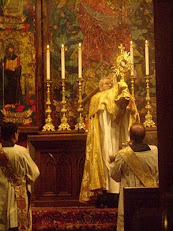Jan. 23, 2012
By Jerry Filteau
WASHINGTON -- How are the new U.S. Catholic ordinariate for former Anglican groups and the 1980 U.S. pastoral provision for Episcopal (Anglican) priests who become Catholics different? What do they have in common? What does the presence of Catholics in the new ordinariate mean for other Catholics?
The pastoral, canonical, ecclesiastical and other questions posed by the new developments are numerous and challenging, but here is an attempt to sort out a few of the bigger ones.
To take the third question first, other Catholics -- Eastern or Latin rite -- who were baptized or confirmed into the church as Latin or Eastern Catholics can legitimately participate in the life and worship of an Anglican-use Catholic community, but ordinarily, they may not become a formal member of that community.
An exception is marriage, for which church laws similar to those applying to Latin-Eastern rite Catholic marriages would come into play: An Eastern or Latin Catholic marrying a Catholic in the new Anglican-use ordinariate could become a member of that ordinariate if the couple agrees on that decision.
Going back to differences and similarities between the 1980 pastoral provision and the new ordinariate, the 1980 provision was aimed chiefly at meeting requests of individual Anglican clergy. It allowed exemptions from celibacy for those who were married and sought to enter into full Communion with the Catholic Church but also wanted to continue their life commitment to ordained ministry, only now as Catholic priests...
Please read the rest of this analysis (Mr. Filteau seems to have a good grasp of the facts, although there are a couple of points that are open to interpretation and not settled) on the web site of the National Catholic Reporter.
Hat tip to Ordinariate Portal
Obituary of a very failed Pontificate
-
"Nun khre methusthen kai tina per bian ponen, epei de katthane
Mursilos."Such would have been the reaction of the unchristianised Greeks.
But for us, for t...
7 months ago














It doesn't seem a particularly good analysis whatsoever and you'd have to wonder whether he had ever read Cardinal Seper's letter to Archbishop Quinn which outlined the Pastoral Provision (it doesn't seem the bishops' conference ever followed through with legislative text that anyone can point to). Near the conclusion, Cardinal Seper wrote: "Finally, I am enclosing a letter which I would be grateful to you for forwarding, after you have taken note of its contents, to Father John Barker of the Pro-Diocese of St. Augustine of Canterbury, informing him that their petition has been accepted in principle." That would hardly sound as though it were addressing "requests of individual Anglican clergy". The main point of the letter is the terms under which common identity of groups could be established. My own analysis would be along the lines that they are nearly exactly the same thing. The difference comes down to the communities under the Pastoral Provision were left up to being left to the discretion of each local Ordinary, and in theory the Ordinariate communities are dependent upon their own Ordinary. While the local bishop is to be consulted, it is no longer his decision as to whether a community is appropriate or not. Individual clergy should certainly be welcome to be incardinated in the Ordinariate where they might eventually be matched to a community. If any choose to instead avail themselves of opportunities through the Pastoral Provision, good luck to them! Father Barker had how many communities in his pro-diocese and after 30 years there are now how many Anglican Use Pastoral Provision parishes?
ReplyDelete